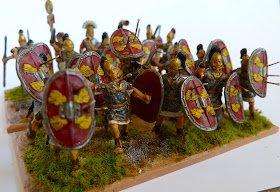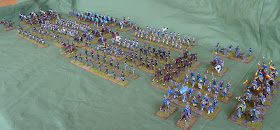Just come home from a rematch with Paul the Galloglaigh, following my drubbing in our first game of Basic Impetus as explained here:
http://dux-homunculorum.blogspot.com/2010/12/first-game-of-basic-impetus.html
We used the same armies for our second game - Nevsky Russians for me and Teutonic Knights for Paul. I lost again, but it was much closer, and the game could definitely have gone either way. My two units of mongols on the left flank literally ran rings around the heavy German knights, destroying a unit of Livonian light horse and even routing the unit of German crusader knights. However, my Druzhina on the left lived up to their reputation of combining the worst features of eastern and western armies. They don't charge hard enough, and they can't skirmish. Although I did a reasonable job of avoiding combat with the bloody unstoppable unit of Teutonic knights, I lost all three units of Druzhina and the game to Livonian light horse and Turcopoles.
Nick was asking for a comparison of DBA and Basic Impetus (BI). I made some observations after the first battle, but I'm going to go out on a limb and say that I think BI is a better game. It is damn good fun. Here's why I like it more than DBA, if you will excuse my midnight rambling:
1. The bigger bases allow for more creative and realistic-looking units.
2. Both games are obviously highly abstract. However, some of the abstraction in DBA has always irked me, particularly related to the use of psiloi and light horse. In DBA, such units don't fight at a distance, but their base contact with an enemy unit represents them skirmishing at short range with missile weapons. If a unit of Light Horse, for example, recoils or flees from an enemy, this represents the skirmishers being pushed away by a controlled charge or whatever by the defending unit.
This all makes sense, but in Basic Impetus all this happens naturally when you use skirmishers. For example, when I sent my mongols against Paul's crusader knights, they were able to gradually start wearing the much tougher unit down. Paul naturally tried to charge my mongols, but I was able to use their ability to move sideways and obliquely to avoid contact. Because Paul had allowed the unit to become isolated, my mongols effectively enveloped the knights, shooting them down from the flank and rear. This seemed much less abstract, and certainly more enjoyable than DBA, where I would have just moved the light horse into base contact with the knights and allowed the dice rolls to represent what we actually played out in BI.
3. The rules for BI are accessible, simple and mostly clearly written. There are a few confusing things - eg the quick reference sheet makes it clear that units can move backwards, but this isn't clear from the paragraph on movement in the rules. However, the Impetus forum supports the game extremely well, with the game creators responding rapidly to rules questions. I have always found DBA to be somewhat arcane.
4. The rules for contacting the enemy in BI are much simpler than in DBA, avoiding the need to make units match up exactly.
5. The gradual attrition units suffer, and the way that a whole series of melees can be fought in a turn as a victorious unit pursues a defeated foe provides a more exciting game than the contact - rebound - contact - rebound - contact - rout nature of DBA.
6. There is greater 'period flavour' in DBA, trying to give armies specific characteristics. For example, the special ability of Roman legionaries to discharge pila differentiates them from other heavy infantry.
I'm trying to think of anything I prefer about DBA. Certainly there are more army lists available for DBA at the moment. I think it is also likely that it would be harder to use DBA in competitions that try to evenly match up armies from 2500BC-AD1500. Medieval knights in BI are a heck of a lot tougher than Sarmatian cataphracts, for example, although both are treated the same in DBA (from memory).
I'd love to hear if anyone has had a different experience of the two games, and would like to champion DBA.
































